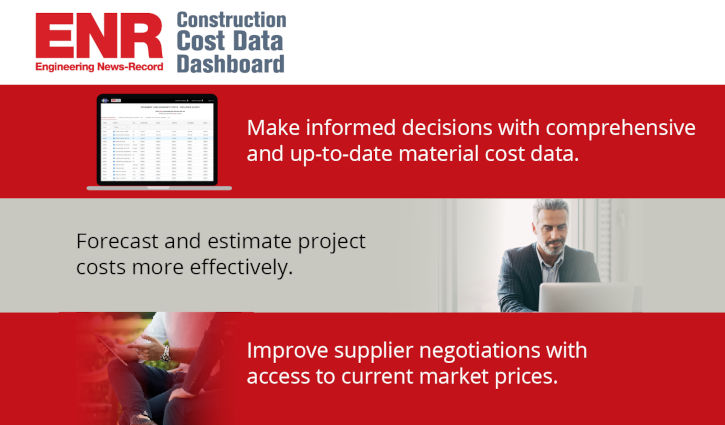Related Links:
ENR 2024 Top 100 Professional Services Firms
ENR 2024 Top 50 Program Management Firms
View complete 2024 list, with full market analysis
(Subscription Required)
In response to ongoing labor challenges across the AEC industry, ENR Top 100 Professional Services Firms are reconfiguring operations to recruit helping hands where they need it most. Yet amid higher construction costs and increased resource competition, firms say there is pressure to reduce project risk, add value and prove their services are worth the price.
The AEC industry’s labor shortage-related challenges are far from new, yet inflated costs have raised the stakes even more around achieving project and profitability goals, according to comments from this year’s ENR Top 100 Construction Management-for-Fee (CM) and Program Management (PM) listed firms. The result is a highly competitive market, says Top 100 firms, where some owners are doubling down on construction and program management services while others hold projects for better market conditions.
A shortage of labor only “exacerbates the lack of efficiency across the industry,” says Bryan Carruthers, Accenture’s North America lead for infrastructure and capital projects. An influx of projects connected to the Infrastructure Investment and Jobs Act, the CHIPS and Science Act, and the Inflation Reduction Act are adding to the urgency for professional services firms to find short-term solutions to the industry’s long-term personnel challenges.
“Many clients are undertaking once-in-a-generation projects, and the pressure on project teams is boundless,” says MGAC President and CEO Mark Anderson. He says projects not managed well “tend to go sideways,” adding: “This is a tough business.”
Owners lean on construction and program managers to ensure the right teams are assembled for the project. “That means performing at a higher level all the time, and ensuring we have the greatest professionals in front of the best clients and the best projects,” says Anderson. “Who wants to play for a second league team?”
Help Wanted
As an intermediary representing the owners’ interests during the project cycle, third-party professional services firms are uniquely positioned to improve project outcomes for all stakeholders. Digging deeper into this equation, Top 100 firms say having the right staff in place is crucial to their success. For this reason, firms say talent recruitment and retention has become their top priority.
Chicago-based Admore Roderick says it has 20 months of backlog and is resource planning for overlapping projects. “This means we need to hire about 25% [more staff], and finding the right people,” explains President and CEO Rashod R. Johnson, “hasn’t been easy.”
Team member recruitment and development is also a top priority for Cumming Group, says the firm’s President and CEO, Derek Hutchison, but he adds that the talent market is also highly competitive.
Balancing Bottom Lines
Labor shortages, coupled with increased material prices and supply chain disruptions, have added additional layers of complexity to project timelines, say Top 100 firms.
In Puerto Rico, CPM President Héctor Javier Rivera says a shortage of civil, mechanical and electrical engineers, combined with the increased cost of importing materials, have stalled the island’s ability to rebuild after seasonal extreme weather events.
Rivera adds, “The need for a skilled workforce combined with elevated cost of material has resulted in a construction environment where the importance of effective planning and value engineering has turned critical to be competitive and hold the projects within budget.”
Overall, Top 100 CM/PM revenue increased 6% to $27.7 billion, from $26.6 billion the year prior. Domestic revenue rose 2.9% to $19.7 billion, and international revenue rose 14.4% to just over $8 billion.
As the Federal Reserve seeks to curb inflation, “All projects are looking to cut costs,” says OAC Services President and CEO Shawn Mahoney.
Kraus-Anderson takes a proactive approach to value engineering by making cost an input for the design process, says Rich Jacobson, COO and executive vice president. “We align project teams, owners and designers to establish clear value targets and optimize project outcomes within budgetary constraints,” he says.
Labor shortages shifted the ways in which professional services firms work, with many firms utilizing prefabrication and modular construction methods to minimize a need for onsite labor and accelerate project timelines.
Improving Project Outcomes
This year, median Top 100 CM/PM firm revenue reached $64.9 million, up slightly from $63.8 million last year. Of the 95 firms who filed revenue both this year and last, 78.9% saw an increase in revenue.
Revenue for the Top 50 CM-for-fee firms and Top 50 PM-for-fee firms continue to trend in opposite directions. Top 50 CM revenue rose 22.5%, to $11.5 billion this year, following a 21.4% increase last year. Top 50 PM revenue, meanwhile, dropped 4.1% after a 1.72% drop last year.
In the private sector, Mahoney says there is a lack of certainty that is leading many owners to shelve complete programs until interest rates drop lower.
“I see signs of activity all across the AEC industry,” says Mahoney. “I just feel we will need to see a reduction in interest rates before owners are willing to start projects back up or initiate new projects.”
McDonough Bolyard Peck Inc. President and CEO Christopher Payne says all markets where the Virginia-based firm has work “continue to be strong.”
“With our prevalence of work in the public sector and the additional funds available at all levels of government, our services are in greater demand than ever before,” says Payne.
Lingering supply chain issues have been a barrier to meeting deadlines. “Electrical and mechanical equipment lead times are driving project schedules. The lead times are long, and the equipment is critical,” explains Adam Jelen, President and CEO of Gilbane Building Co. The firm often recommends their clients release MEP packages very early in the design process to meet the project schedule.
For Cumming Group, design flexibility can be key. “For our clients in the semiconductor and data-center spaces, the pace of technology advancement in some cases can outpace the speed of constructing these spaces,” says Hutchison. Some of those clients opt to start with a shell and basic requirements—size, power requirements, data capacity—and determine the exact fit-out later in the project. “From a contracting perspective, this translates to a bit more separation in the procurement strategy from a GC building the shell and then bringing in multiprime subcontractors as the design is finalized,” he says.
Investing in Innovation
Overall, this year’s Top 100 CM/PM firms overwhelmingly agreed that artificial intelligence was poised to have the biggest impact on the way in which they work, with firms investing in the technology to varying degrees to give their teams some digital helping hands.
Last year, Accenture announced a $3 billion investment in AI and is also helping its clients use generative AI “with over 53,000 skilled data and AI practitioners,” explains Carruthers. “Additionally, we have built many proprietary digital accelerators and platforms, which integrate and aggregate data across disparate systems to drive process efficiencies and distill information into actionable insights and forecasts to improve decision-making for our clients’ projects,” he says. “We see massive potential for using the technology to explore and stress-test more design and execution options.”
Adding to CPM’s interest in AI, Rivera says the firm is also investing in drones, 3D mapping, thermography and aerial imaging technology to conduct site surveys, improve progress monitoring and capture high-resolution imagery for better project planning and documentation.
Rivera adds that the firm has also implemented the use of PMIS software for better team collaboration, document management and to track project progress.
“By leveraging these data and analytics, we can continuously monitor and evaluate project performance, identify areas for improvement and implement targeted interventions to enhance overall project success and deliver value to our clients,” says Rivera.
Cumming Group’s Hutchison adds, “The more complex the project, the greater the need for highly specialized project teams committed to building value through their expertise.”












Post a comment to this article
Report Abusive Comment